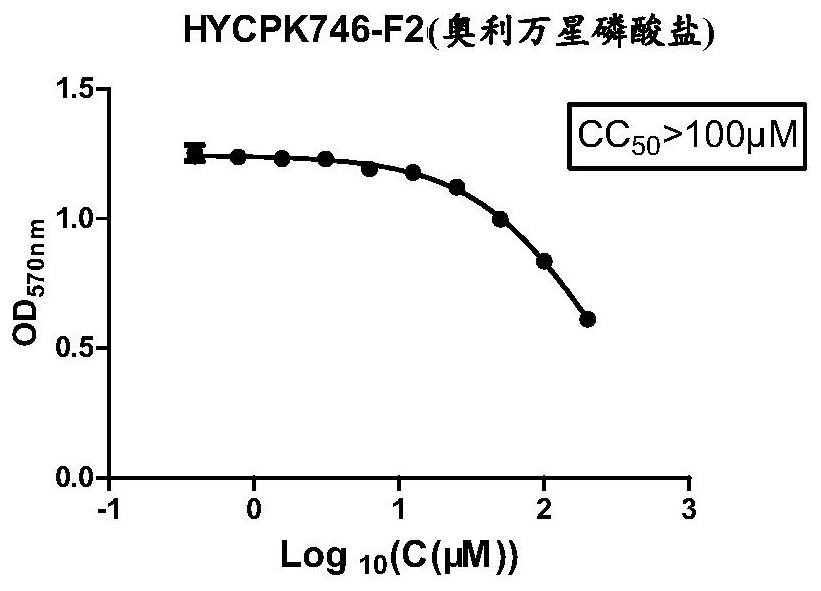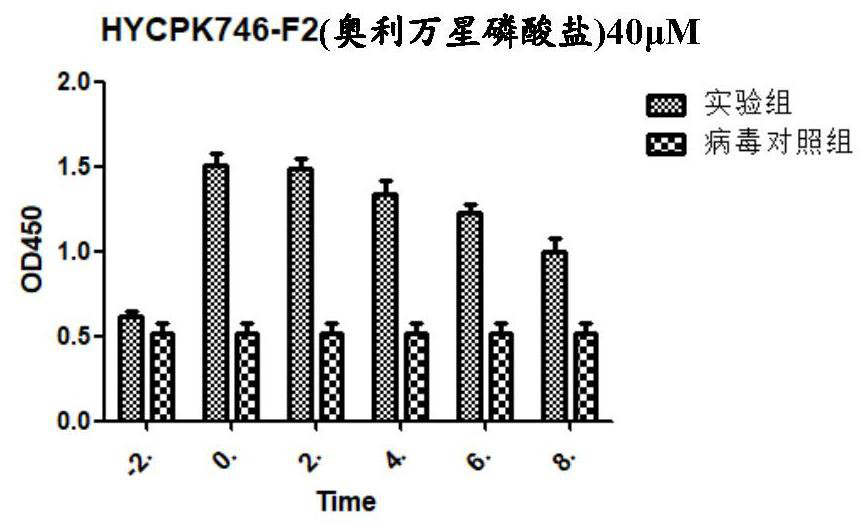Application of Oritavancin Phosphate in Preparation of Drugs for Prevention and Treatment of Bovine Infectious Rhinotracheitis
A technology for oritavancin phosphate and rhinotracheitis, applied in the field of medicine, can solve problems such as hidden safety hazards, inability to remove viruses, differential diagnosis and the like
- Summary
- Abstract
- Description
- Claims
- Application Information
AI Technical Summary
Problems solved by technology
Method used
Image
Examples
Embodiment 1
[0041] Example 1 Bovine Infectious Rhinotracheitis Virus TCID 50 determination of
[0042] MDBK cells (preserved by the Dairy Cattle Research Center of Shandong Academy of Agricultural Sciences) were digested with 1 × 10 cells per well. 5 Cells / mL were seeded into 96-well cell culture plates at 37°C, 5% CO. 2 After culturing into a monolayer of cells in a cell incubator, discard the cell growth solution in the well, and serially diluted the virus dilution solution of bovine infectious rhinotracheitis virus (preserved by the Dairy Cattle Research Center of Shandong Academy of Agricultural Sciences) by 10 times (dilutions respectively). is 10 -1 ~10 -10 ) were seeded in a 96-well plate full of monolayer cells, 100 μL per well, and placed in 37°C, 5% CO. 2 Continue to culture in the incubator, and observe the CPE (cytopathic effect) of the cells daily, and record the number of cytopathic wells in detail. At the same time, a normal cell control group and a blank control gro...
Embodiment 2
[0053] Example 2 Toxicity test of oritavancin phosphate on MDBK cells:
[0054] MDBK cells are susceptible cells for bovine infectious rhinotracheitis virus. Therefore, the cytotoxicity of oritavancin phosphate on MDBK cells was first detected, and the specific experimental steps were as follows:
[0055] (1) Inoculate 100 μL of cells (5000 MDBK cells / well) in a 96-well plate.
[0056] (2) After culturing for about 12 hours, proceed to the next step of dosing analysis. Discard the culture medium, add 100 μL of 2% FBS DMEM containing different drug concentrations (50 μM as the starting concentration, 25 μM, 12.5 μM, 6.25 μM, 3.125 μM and other 9 concentrations) in each well. Do 3 parallels for each concentration. Control wells at the same time: add 100 μL of 2% FBS DMEM medium containing 0.9% DMSO. Zero well: Do not plate cells.
[0057] (3) At 37°C, 5% CO 2 After 48 hours of culture under the conditions, the medium in the wells was discarded. Wash twice with 100 μL PB...
Embodiment 3
[0062] Example 3 Inhibition experiment of oritavancin phosphate on bovine infectious rhinotracheitis virus:
[0063] (1) Inoculate 1 × 10 in each well of a 96-well plate 4 MDBK cells, 37°C, 5% CO 2 overnight in an incubator;
[0064] (2) Discard the medium and add 100μL of 100TCID to each well 50 Bovine Infectious Rhinotracheitis Virus Dilution Solution (with 2% FBS DMEM cells, add the virus dilution solution, according to the initial concentration of 50 μM, twice the concentration gradient dilution dosing, 5% CO 2 cultivated in an incubator;
[0065] (3) After 48 hours, operate according to the instructions of the CCK-8 kit, and use a microplate reader to measure the OD value at 450 nm.
[0066](4) Analysis of data, virus inhibition rate (%)=(D450nm value of drug treatment group-D450nm value of virus control group) / (D450nm value of normal cell control group-D450nm value of virus control group)×100%, obtained by GraphPad Prism5 software The half effective concentration ...
PUM
 Login to View More
Login to View More Abstract
Description
Claims
Application Information
 Login to View More
Login to View More - R&D
- Intellectual Property
- Life Sciences
- Materials
- Tech Scout
- Unparalleled Data Quality
- Higher Quality Content
- 60% Fewer Hallucinations
Browse by: Latest US Patents, China's latest patents, Technical Efficacy Thesaurus, Application Domain, Technology Topic, Popular Technical Reports.
© 2025 PatSnap. All rights reserved.Legal|Privacy policy|Modern Slavery Act Transparency Statement|Sitemap|About US| Contact US: help@patsnap.com



